FDA无菌生产cGMP指南(中文)[1]
美国FDA生产过程(工艺)验证总则指南中英文版
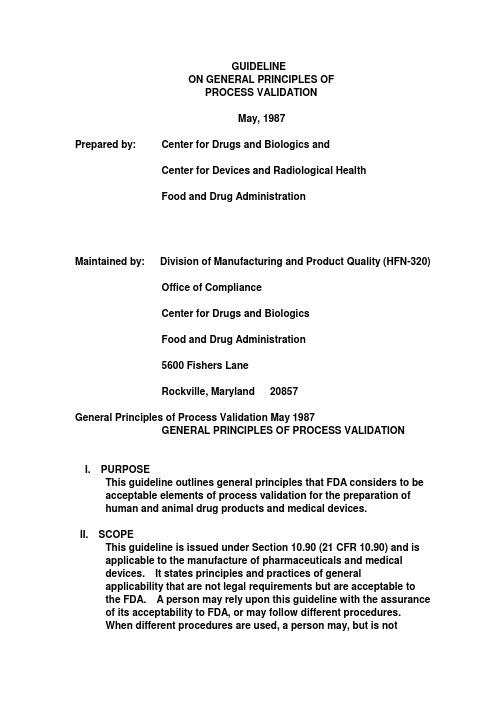
GUIDELINEON GENERAL PRINCIPLES OFPROCESS VALIDATIONMay, 1987Prepared by: Center for Drugs and Biologics andCenter for Devices and Radiological HealthFood and Drug AdministrationMaintained by: Division of Manufacturing and Product Quality (HFN-320)Office of ComplianceCenter for Drugs and BiologicsFood and Drug Administration5600 Fishers LaneRockville, Maryland 20857General Principles of Process Validation May 1987GENERAL PRINCIPLES OF PROCESS VALIDATIONI. PURPOSEThis guideline outlines general principles that FDA considers to beacceptable elements of process validation for the preparation ofhuman and animal drug products and medical devices.II. SCOPEThis guideline is issued under Section 10.90 (21 CFR 10.90) and isapplicable to the manufacture of pharmaceuticals and medicaldevices. It states principles and practices of generalapplicability that are not legal requirements but are acceptable tothe FDA. A person may rely upon this guideline with the assurance of its acceptability to FDA, or may follow different procedures.When different procedures are used, a person may, but is notrequired to, discuss the matter in advance with FDA to prevent theexpenditure of money and effort on activities that may later bedetermined to be unacceptable. In short, this guideline listsprinciples and practices which are acceptable to the FDA for theprocess validation of drug products and medical devices; it doesnot list the principles and practices that must, in all instances,be used to comply with law.-1-This guideline may be amended from time to time. Interestedpersons are invited to submit comments on this document and anysubsequent revisions. Written comments should be submitted to the Dockets Management Branch (HFA-305), Food and Drug Administration,Room 4-62, 5600 Fishers Lane, Rockville, Maryland 20857. Receivedcomments may be seen in that office between 9\a.m. and 4\p.m.,Monday through Friday.III. INTRODUCTIONProcess validation is a requirement of the Current GoodManufacturing Practices Regulations for Finished Pharmaceuticals,21 CFR Parts 210 and 211, and of the Good Manufacturing PracticeRegulations for Medical Devices, 21 CFR Part 820, and therefore, isapplicable to the manufacture of pharamaceuticals and medicaldevices.Several firms have asked FDA for specific guidance on what FDAexpects firms to do to assure compliance with the requirements forprocess validation. This guideline discusses process validationelements and concepts that are considered by FDA as acceptableparts of a validation program. The constituents of validationpresented in this document are not intended to be all-inclusive.FDA recognizes that, because of the great variety of medicalproducts (drug products and medical devices), processes and-2-manufacturing facilities, it is not possible to state in onedocument all of the specific validation elements that areapplicable. Several broad concepts, however, have generalapplicability which manufacturers can use successfully as a guidein validating a manufacturing process. Although the particular requirements of process validation will vary according to such factors as the nature of the medical product (e.g., sterile vsnon-sterile) and the complexity of the process, the broad concepts stated in this document have general applicability and provide an acceptable framework for building a comprehensive approach to process validation.DefinitionsInstallation qualification - Establishing confidence that process equipment and ancillary systems are capable of consistently operating within established limits and tolerances.Process performance qualification - Establishing confidence thatthe process is effective and reproducible.Product performance qualification - Establishing confidence through appropriate testing that the finished product produced by aspecified process meets all release requirements for functionalityand safety.-3-Prospective validation - Validation conducted prior to thedistribution of either a new product, or product made under arevised manufacturing process, where the revisions may affect the product's characteristics.Retrospective validation - Validation of a process for a product already in distribution based upon accumulated production, testing and control data.Validation - Establishing documented evidence which provides a high degree of assurance that a specific process will consistentlyproduce a product meeting its pre-determined specifications and quality attributes.Validation protocol - A written plan stating how validation will be conducted, including test parameters, product characteristics, production equipment, and decision points on what constitutes acceptable test results.Worst case - A set of conditions encompassing upper and lowerprocessing limits and circumstances, including those withinstandard operating procedures, which pose the greatest chance ofprocess or product failure when compared to ideal conditions. Such conditions do not necessarily induce product or process failure.-4-IV. GENERAL CONCEPTSAssurance of product quality is derived from careful attention to anumber of factors including selection of quality parts andmaterials, adequate product and process design, control of theprocess, and in-process and end-product testing. Due to thecomplexity of today's medical products, routine end-product testingalone often is not sufficient to assure product quality for severalreasons. Some end-product tests have limited sensitivity.1 Insome cases, destructive testing would be required to show that themanufacturing process was adequate, and in other situationsend-product testing does not reveal all variations that may occurin the product that may impact on safety and effectiveness.2The basic principles of quality assurance have as their goal theproduction of articles that are fit for their intended use. These1 For example, USP XXI states: "No sampling plan for applyingsterility tests to a specified proportion of discrete unitsselected from a sterilization load is capable of demonstrating withcomplete assurance that all of the untested units are in factsterile."2 As an example, in one instance a visual inspection failed to detecta defective structural weld which resulted in the failure of aninfant warmer. The defect could only have been detected by usingdestructive testing or expensive test equipment.-5-principles may be stated as follows: (1) quality, safety, and effectiveness must be designed and built into the product; (2) quality cannot be inspected or tested into the finished product;and (3) each step of the manufacturing process must be controlled to maximize the probability that the finished product meets all quality and design specifications. Process validation is a key element in assuring that these quality assurance goals are met.It is through careful design and validation of both the process and process controls that a manufacturer can establish a high degree of confidence that all manufactured units from successive lots will be acceptable. Successfully validating a process may reduce the dependence upon intensive in-process and finished product testing. It should be noted that in most all cases, end-product testingplays a major role in assuring that quality assurance goals are met; i.e., validation and end-product testing are not mutually exclusive.The FDA defines process validation as follows:Process validation is establishing documented evidence which provides a high degree of assurance that a specific process will consistently produce a product meeting its pre-determinedspecifications and quality characteristics.-6-It is important that the manufacturer prepare a written validation protocol which specifies the procedures (and tests) to be conducted and the data to be collected. The purpose for which data are collected must be clear, the data must reflect facts and becollected carefully and accurately. The protocol should specify a sufficient number of replicate process runs to demonstrate reproducibility and provide an accurate measure of variability among successive runs. The test conditions for these runs should encompass upper and lower processing limits and circumstances, including those within standard operating procedures, which pose the greatest chance of process or product failure compared to ideal conditions; such conditions have become widely known as "worst case" conditions. (They are sometimes called "most appropriate challenge" conditions.) Validation documentation should include evidence of the suitability of materials and the performance and reliability of equipment and systems.Key process variables should be monitored and documented. Analysisof the data collected from monitoring will establish thevariability of process parameters for individual runs and willestablish whether or not the equipment and process controls areadequate to assure that product specifications are met.-7-Finished product and in-process test data can be of value inprocess validation, particularly in those situations where qualityattributes and variabilities can be readily measured. Wherefinished (or in-process) testing cannot adequately measure certainattributes, process validation should be derived primarily fromqualification of each system used in production and fromconsideration of the interaction of the various systems.V. CGMP REGULATIONS FOR FINISHED PHARMACEUTICALS Process validation is required, in both general and specific terms,by the Current Good Manufacturing Practice Regulations for FinishedPharmaceuticals, 21 CFR Parts 210 and 211. Examples of suchrequirements are listed below for informational purposes, and arenot all-inclusive.A requirement for process validation is set forth in general termsin section\211.100 -- Written procedures; deviations -- whichstates, in part:"There shall be written procedures for production and processcontrol designed to assure that the drug products have theidentity, strength, quality, and purity they purport or arerepresented to possess."-8-Several sections of the CGMP regulations state validationrequirements in more specific terms. Excerpts from some ofthese sections are:Section 211.110, Sampling and testing of in-processmaterials and drug products.(a) "....control procedures shall be established to monitor theoutput and VALIDATE the performance of those manufacturingprocesses that may be responsible for causing variability in thecharacteristics of in-process material and the drug product."(emphasis added)Section 211.113, Control of Microbiological Contamination.(b) "Appropriate written procedures, designed to preventmicrobiological contamination of drug products purporting to besterile, shall be established and followed. Such proceduresshall include VALIDATION of any sterilization process."(emphasis added)VI. GMP REGULATION FOR MEDICAL DEVICESProcess validation is required by the medical device GMPRegulations, 21 CFR Part\820. Section 820.5 requires everyfinished device manufacturer to:"...prepare and implement a quality assurance program that isappropriate to the specific device manufactured..."-9-Section 820.3(n) defines quality assurance as:"...all activities necessary to verify confidence in the qualityof the process used to manufacture a finished device."When applicable to a specific process, process validation is anessential element in establishing confidence that a process willconsistently produce a product meeting the designed qualitycharacteristics.A generally stated requirement for process validation is containedin section\820.100:"Written manufacturing specifications and processing proceduresshall be established, implemented, and controlled to assure thatthe device conforms to its original design or any approvedchanges in that design."Validation is an essential element in the establishment andimplementation of a process procedure, as well as in determiningwhat process controls are required in order to assure conformanceto specifications.Section 820.100(a)(1) states:"...control measures shall be established to assure that thedesign basis for the device, components and packaging iscorrectly translated into approved specifications."-10-Validation is an essential control for assuring that thespecifications for the device and manufacturing process areadequate to produce a device that will conform to the approveddesign characteristics.VII. PRELIMINARY CONSIDERATIONSA manufacturer should evaluate all factors that affect productquality when designing and undertaking a process validation study.These factors may vary considerably among different products andmanufacturing technologies and could include, for example,component specifications, air and water handling systems,environmental controls, equipment functions, and process controloperations. No single approach to process validation will beappropriate and complete in all cases; however, the followingquality activities should be undertaken in most situations.During the research and development (R&D) phase, the desiredproduct should be carefully defined in terms of itscharacteristics, such as physical, chemical, electrical and-11-performance characteristics.3 It is important to translate theproduct characteristics into specifications as a basis fordescription and control of the product.Documentation of changes made during development providetraceability which can later be used to pinpoint solutions tofuture problems.The product's end use should be a determining factor in thedevelopment of product (and component) characteristics andspecifications. All pertinent aspects of the product which impacton safety and effectiveness should be considered. These aspects3 For example, in the case of a compressed tablet, physicalcharacteristics would include size, weight, hardness, and freedomfrom defects, such as capping and splitting. Chemicalcharacteristics would include quantitative formulation/potency;performance characteristics may include bioavailability (reflectedby disintegration and dissolution). In the case of blood tubing,physical attributes would include internal and external diameters,length and color. Chemical characteristics would include rawmaterial formulation. Mechanical properties would include hardness and tensile strength; performance characteristics would includebiocompatibility and durability.-12-include performance, reliability and stability. Acceptable rangesor limits should be established for each characteristic to set upallowable variations.4 These ranges should be expressed inreadily measurable terms.The validity of acceptance specifications should be verifiedthrough testing and challenge of the product on a sound scientificbasis during the initial development and production phase.Once a specification is demonstrated as acceptable it is importantthat any changes to the specification be made in accordance withdocumented change control procedures.VIII. ELEMENTS OF PROCESS VALIDATIONA. Prospective ValidationProspective validation includes those considerations that should bemade before an entirely new product is introduced by a firm or whenthere is a change in the manufacturing process which may affect theproduct's characteristics, such as uniformity and identity. Thefollowing are considered as key elements of prospective validation.4 For example, in order to assure that an oral, ophthalmic, orparenteral solution has an acceptable pH, a specification may beestablished by which a lot is released only if it has been shown tohave a pH within a narrow established range. For a device, aspecification for the electrical resistance of a pacemaker leadwould be established so that the lead would be acceptable only ifthe resistance was within a specified range.-13-1. Equipment and ProcessThe equipment and process(es) should be designed and/or selectedso that product specifications are consistently achieved. Thisshould be done with the participation of all appropriate groupsthat are concerned with assuring a quality product, e.g.,engineering design, production operations, and quality assurancepersonnel.a. Equipment: Installation QualificationInstallation qualification studies establish confidence thatthe process equipment and ancillary systems are capable ofconsistently operating within established limits andtolerances. After process equipment is designed orselected, it should be evaluated and tested to verify thatit is capable of operating satisfactorily within theoperating limits required by the process.5 This phase ofvalidation includes examination of equipment design;determination of calibration, maintenance, and adjustmentrequirements; and identifying critical equipment featuresthat could affect the process and product. Informationobtained from these studies should be used to establishwritten procedures covering equipment calibration,maintenance, monitoring, and control.5 Examples of equipment performance characteristics which maybe measured include temperature and pressure of injectionmolding machines, uniformity of speed for mixers,temperature, speed and pressure for packaging machines, andtemperature and pressure of sterilization chambers.-14-In assessing the suitability of a given piece of equipment,it is usually insufficient to rely solely upon therepresentations of the equipment supplier, or uponexperience in producing some other product.6 Soundtheoretical and practical engineering principles andconsiderations are a first step in the assessment.It is important that equipment qualification simulate actualproduction conditions, including those which are "worstcase" situations.6 The importance of assessing equipment suitability based uponhow it will be used to attain desired product attributes isillustrated in the case of deionizers used to producePurified Water, USP. In one case, a firm used such water tomake a topical drug product solution which, in view of itsintended use, should have been free from objectionablemicroorganisms. However, the product was found to becontaminated with a pathogenic microorganism. The apparentcause of the problem was failure to assess the performanceof the deionizer from a microbiological standpoint. It isfairly well recognized that the deionizers are prone tobuild-up of microorganisms--especially if the flow rates arelow and the deionizers are not recharged and sanitized atsuitable intervals. Therefore, these factors should havebeen considered. In this case, however, the firm reliedupon the representations of the equipment itself, namely the"recharge" (i.e., conductivity) indicator, to signal thetime for regeneration and cleaning. Considering the desiredproduct characteristics, the firm should have determined theneed for such procedures based upon pre-use testing, takinginto account such factors as the length of time theequipment could produce deionized water of acceptablequality, flow rate, temperature, raw water quality,frequency of use, and surface area of deionizing resins.-15-Tests and challenges should be repeated a sufficient numberof times to assure reliable and meaningful results. Allacceptance criteria must be met during the test orchallenge. If any test or challenge shows that theequipment does not perform within its specifications, anevaluation should be performed to identify the cause of thefailure. Corrections should be made and additional testruns performed, as needed, to verify that the equipmentperforms within specifications. The observed variability ofthe equipment between and within runs can be used as a basisfor determining the total number of trials selected for thesubsequent performance qualification studies of theprocess.7Once the equipment configuration and performancecharacteristics are established and qualified, they shouldbe documented. The installation qualification shouldinclude a review of pertinent maintenance procedures, repairparts lists, and calibration methods for each piece ofequipment. The objective is to assure that all repairs canbe performed in such a way that will not affect the7 For example, the AAMI Guideline for Industrial EthyleneOxide Sterilization of Medical Devices approved 2 December 1981, states: "The performance qualification should includea minimum of 3 successful, planned qualification runs, inwhich all of the acceptance criteria are met.....(5.3.1.2.).-16-characteristics of material processed after the repair. Inaddition, special post-repair cleaning and calibrationrequirements should be developed to prevent inadvertentmanufacture a of non-conforming product. Planning during the qualification phase can prevent confusion duringemergency repairs which could lead to use of the wrongreplacement part.b. Process: Performance QualificationThe purpose of performance qualification is to providerigorous testing to demonstrate the effectiveness andreproducibility of the process. In entering the performance qualification phase of validation, it is understood that theprocess specifications have been established and essentially proven acceptable through laboratory or other trial methods and that the equipment has been judged acceptable on thebasis of suitable installation studies.Each process should be defined and described with sufficient specificity so that employees understand what is required.-17-Parts of the process which may vary so as to affectimportant product quality should be challenged.8In challenging a process to assess its adequacy, it isimportant that challenge conditions simulate those that willbe encountered during actual production, including "worstcase" conditions. The challenges should be repeated enoughtimes to assure that the results are meaningful andconsistent.8 For example, in electroplating the metal case of animplantable pacemaker, the significant process steps todefine, describe, and challenge include establishment andcontrol of current density and temperature values forassuring adequate composition of electrolyte and forassuring cleanliness of the metal to be plated. In theproduction of parenteral solutions by aseptic filling, thesignificant aseptic filling process steps to define andchallenge should include the sterilization anddepyrogenation of containers/closures, sterilization ofsolutions, filling equipment and product contact surfaces,and the filling and closing of containers.-18-Each specific manufacturing process should be appropriatelyqualified and validated. There is an inherent danger inrelying on what are perceived to be similarities betweenproducts, processes, and equipment without appropriatechallenge.9c. Product: Performance QualificationFor purposes of this guideline, product performancequalification activities apply only to medical devices.These steps should be viewed as pre-production qualityassurance activities.9 For example, in the production of a compressed tablet, afirm may switch from one type of granulation blender toanother with the erroneous assumption that both types have similar performance characteristics, and, therefore,granulation mixing times and procedures need not bealtered. However, if the blenders are substantiallydifferent, use of the new blender with procedures used forthe previous blender may result in a granulation with poorcontent uniformity. This, in turn, may lead to tabletshaving significantly differing potencies. This situationmay be averted if the quality assurance system detects theequipment change in the first place, challenges the blender performance, precipitates a revalidation of the process, and initiates appropriate changes. In this example,revalidation comprises installation qualification of the newequipment and performance qualification of the processintended for use in the new blender.-19-Before reaching the conclusion that a process has beensuccessfully validated, it is necessary to demonstrate thatthe specified process has not adversely affected thefinished product. Where possible, product performancequalification testing should include performance testingunder conditions that simulate actual use. Productperformance qualification testing should be conducted usingproduct manufactured from the same type of productionequipment, methods and procedures that will be used forroutine production. Otherwise, the qualified product maynot be representative of production units and cannot be usedas evidence that the manufacturing process will produce aproduct that meets the pre-determined specifications andquality attributes.1010 For example, a manufacturer of heart valves receivedcomplaints that the valve-support structure was fracturingunder use. Investigation by the manufacturer revealed thatall material and dimensional specifications had been met butthe production machining process created microscopicscratches on the valve supporting wireform. These scratchescaused metal fatigue and subsequent fracture. Comprehensivefatigue testing of production units under simulated useconditions could have detected the process deficiency.In another example, a manufacturer recalled insulin syringesbecause of complaints that the needles were clogged.Investigation revealed that the needles were clogged bysilicone oil which was employed as a lubricant duringmanufacturing. Investigation further revealed that themethod used to extract the silicone oil was only partiallyeffective. Although visual inspection of the syringesseemed to support that the cleaning method was effective,actual use proved otherwise.-20-After actual production units have sucessfully passed product performance qualification, a formal technical review should be conducted and should include:o Comparison of the approved product specifications and the actual qualified product.o Determination of the validity of test methods used to determine compliance with the approved specifications.o Determination of the adequacy of the specification change control program.2. System to Assure Timely RevalidationThere should be a quality assurance system in place which requires revalidation whenever there are changes in packaging, formulation, equipment, or processes which could impact on product effectiveness or product characteristics, and whenever there are changes in product characteristics. Furthermore, when a change is made in raw material supplier, the manufacturer should consider subtle, potentially adverse differences in theraw material characteristics. A determination of adverse differences in raw material indicates a need to revalidate the process.-21-One way of detecting the kind of changes that should initiate revalidation is the use of tests and methods of analysis whichare capable of measuring characteristics which may vary. Such tests and methods usually yield specific results which go beyond the mere pass/fail basis, thereby detecting variations within product and process specifications and allowing determination of whether a process is slipping out of control.The quality assurance procedures should establish the circumstances under which revalidation is required. These may be based upon equipment, process, and product performance observed during the initial validation challenge studies. It is desirable to designate individuals who have the responsibilityto review product, process, equipment and personnel changes to determine if and when revalidation is warranted.。
美国cGMP 中英文对照版
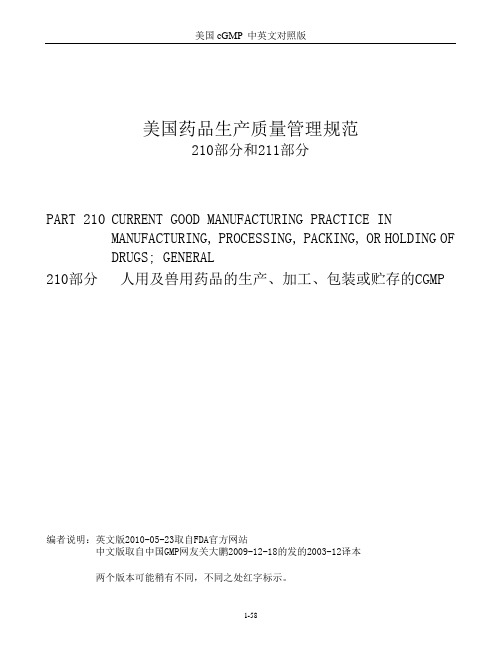
美国 cGMP 中英文对照版 (c) An investigational drug for use in a phase 1 study, as described in 312.21(a) of this chapter, is subject to the statutory requirements set forth in 21 U.S.C. 351(a)(2)(B). The production of such drug is exempt from compliance with the regulations in part 211 of this chapter. However, this exemption does not apply to an investigational drug for use in a phase 1 study once the investigational drug has been made available for use by or for the sponsor in a phase 2 or phase 3 study, as described in 312.21(b) and (c) of this chapter, or the drug has been lawfully marketed. If the investigational drug has been made available in a phase 2 or phase 3 study or the drug has been lawfully marketed, the drug for use in the phase 1 study must comply with part 211.
fda无菌工艺生产指南

fda无菌工艺生产指南1. 引言1.1 概述在生物制药和医疗器械行业,为了确保产品的质量和安全性,无菌工艺生产是至关重要的环节。
无菌工艺生产是指通过采取适当措施以防止细菌和其他微生物的污染,从而达到无菌状态的生产过程。
美国食品药品监督管理局(FDA)作为全球权威的监管机构,对无菌工艺生产提供了一套完整的指南。
1.2 文章结构本文将首先介绍FDA无菌工艺生产指南的背景和重要性,然后详细介绍该指南所包含的各项要求和实施措施。
在此基础上,还将讨论无菌工艺生产的重要性,并说明遵循国际标准与规定的必要性。
最后,总结已有研究成果及观点,并对未来发展进行展望。
1.3 目的本文旨在全面介绍FDA无菌工艺生产指南并分析其对于保障产品质量、安全性以及遵循国际标准与规定的重要性。
通过深入理解这些指导原则,生物制药和医疗器械行业的从业人员将能够更好地掌握无菌工艺生产的要求和措施,进而提升产品质量和安全性,满足监管机构的要求。
2. FDA无菌工艺生产指南2.1 简介无菌工艺生产指南是美国食品药品监督管理局(FDA)为了确保医疗产品和制药过程的安全性和质量而制定的准则。
无菌工艺生产是一种在没有任何微生物污染的条件下进行产品加工和包装的方法。
该指南旨在提供针对无菌环境和设备要求、操作程序以及清洁消毒控制方面的详细指导。
2.2 标准要求FDA对无菌工艺生产提出了一系列严格的标准要求,以确保产品在整个制造过程中都处于无菌状态。
这些标准要求包括但不限于:- 清洁消毒程序:必须制定有效的清洁消毒程序,确保所有接触于产品、容器、设备和环境表面的杂质被充分去除或灭活。
- 设备验证:所有用于无菌工艺生产的设备都需要经过验证,以确认它们能够提供足够的杀灭微生物的能力,并且不会引入新的污染源。
- 环境控制:必须建立合适的环境控制系统,包括空气过滤和压力控制,以防止非无菌物质进入生产区域。
- 包装材料检测:所有用于包装的材料都需要经过严格的检测,以确保其没有微生物污染或释放出可能引起污染的物质。
美国FDA CGMP英汉对照版
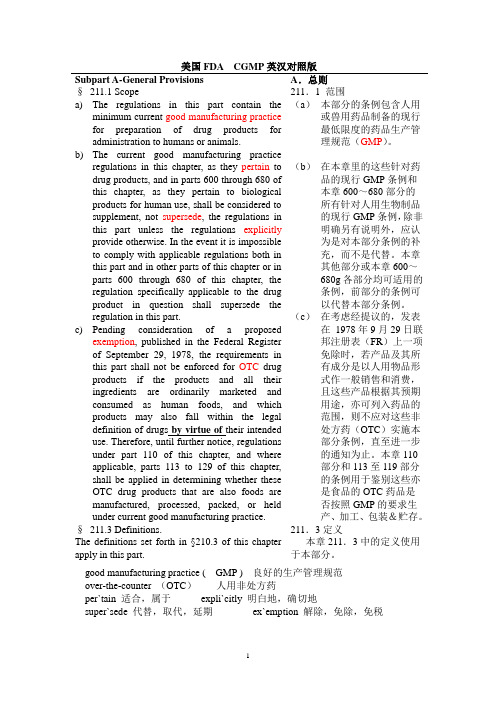
美国FDA CGMP英汉对照版Subpart A-General Provisions§211.1 Scopea)The regulations in this part contain theminimum current good manufacturing practice for preparation of drug products for administration to humans or animals.b)The current good manufacturing practiceregulations in this chapter, as they pertain to drug products, and in parts 600 through 680 of this chapter, as they pertain to biological products for human use, shall be considered to supplement, not supersede, the regulations in this part unless the regulations explicitly provide otherwise. In the event it is impossible to comply with applicable regulations both in this part and in other parts of this chapter or in parts 600 through 680 of this chapter, the regulation specifically applicable to the drug product in question shall supersede the regulation in this part.c)Pending consideration of a proposedexemption, published in the Federal Register of September 29, 1978, the requirements in this part shall not be enforced for OTC drug products if the products and all their ingredients are ordinarily marketed and consumed as human foods, and which products may also fall within the legal definition of drugs by virtue of their intended use. Therefore, until further notice, regulations under part 110 of this chapter, and where applicable, parts 113 to 129 of this chapter, shall be applied in determining whether these OTC drug products that are also foods are manufactured, processed, packed, or held under current good manufacturing practice.§211.3 Definitions.The definitions set forth in §210.3 of this chapter apply in this part.A.总则211.1 范围(a)本部分的条例包含人用或兽用药品制备的现行最低限度的药品生产管理规范(GMP)。
FDA无菌加工生产的无菌药品指南中英文对照版
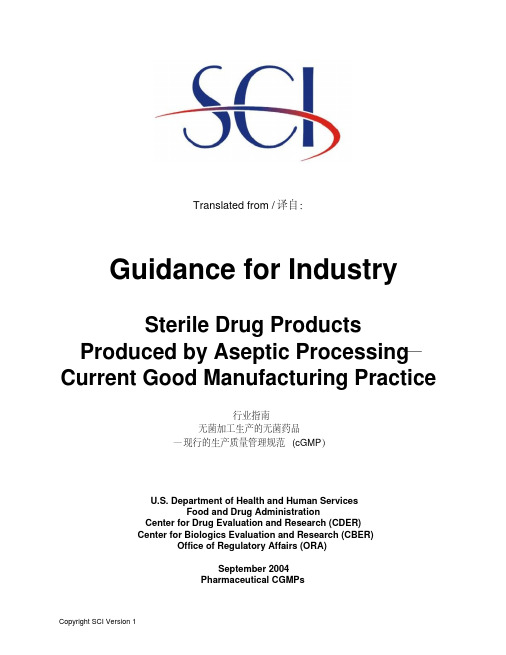
监控程序
VI. COMPONENTS AND CONTAINER/CLOSURES .................................................... 27
药品成分和容器 /密封 A. Components..................................................................................................................................27
法规架构 B. Technical Framework .......................................................................................................iologics Evaluation and Research Food and Drug Administration
1401 Rockville Pike, Rockville, MD 20852-1448 /cber/guidelines.htm.
辅助洁净区域 C. Clean Area Separation ................................................................................................................ 11
净化区的隔离 D. Air Filtration ................................................................................................................................ 12
无菌药品和无菌工艺行业指南翻译
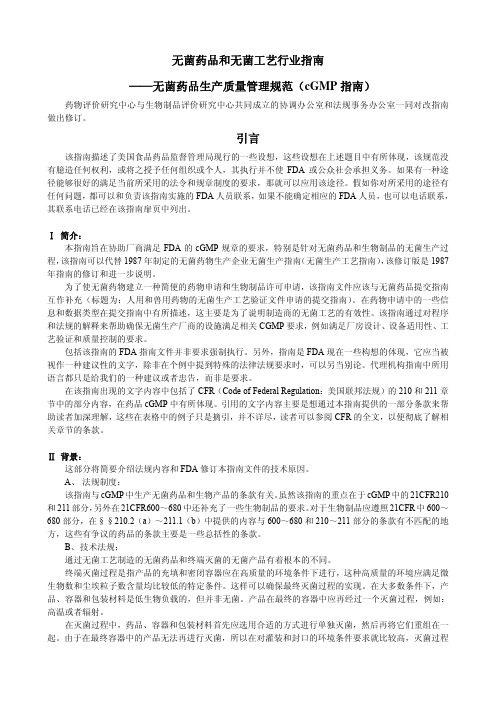
无菌药品和无菌工艺行业指南——无菌药品生产质量管理规范(cGMP指南)药物评价研究中心与生物制品评价研究中心共同成立的协调办公室和法规事务办公室一同对改指南做出修订。
引言该指南描述了美国食品药品监督管理局现行的一些设想,这些设想在上述题目中有所体现,该规范没有臆造任何权利,或将之授予任何组织或个人,其执行并不使FDA或公众社会承担义务。
如果有一种途径能够很好的满足当前所采用的法令和规章制度的要求,那就可以应用该途径。
假如你对所采用的途径有任何问题,都可以和负责该指南实施的FDA人员联系,如果不能确定相应的FDA人员,也可以电话联系,其联系电话已经在该指南扉页中列出。
Ⅰ简介:本指南旨在协助厂商满足FDA的cGMP规章的要求,特别是针对无菌药品和生物制品的无菌生产过程,该指南可以代替1987年制定的无菌药物生产企业无菌生产指南(无菌生产工艺指南),该修订版是1987年指南的修订和进一步说明。
为了使无菌药物建立一种简便的药物申请和生物制品许可申请,该指南文件应该与无菌药品提交指南互作补充(标题为:人用和兽用药物的无菌生产工艺验证文件申请的提交指南)。
在药物申请中的一些信息和数据类型在提交指南中有所描述,这主要是为了说明制造商的无菌工艺的有效性。
该指南通过对程序和法规的解释来帮助确保无菌生产厂商的设施满足相关CGMP要求,例如满足厂房设计、设备适用性、工艺验证和质量控制的要求。
包括该指南的FDA指南文件并非要求强制执行。
另外,指南是FDA现在一些构想的体现,它应当被视作一种建议性的文字,除非在个例中提到特殊的法律法规要求时,可以另当别论。
代理机构指南中所用语言都只是给我们的一种建议或者忠告,而非是要求。
在该指南出现的文字内容中包括了CFR(Code of Federal Regulation:美国联邦法规)的210和211章节中的部分内容,在药品cGMP中有所体现。
引用的文字内容主要是想通过本指南提供的一部分条款来帮助读者加深理解,这些在表格中的例子只是摘引,并不详尽,读者可以参阅CFR的全文,以便彻底了解相关章节的条款。
FDA无菌生产cGMP指南
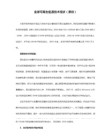
洁净级别
ISO定义
洁净级别b
颗粒度指标6
(≥0.5μm/立方米)
悬浮菌指标c
(cfu/立方米)
沉降菌指标c,d
(90mm直径培养皿, cfu/4小时)
1005 3,520 1e 1e
1000 6 35,200 7 3
10,000 7 352,000 10 5
对于生物制剂产品(从属于21 CFR parts
600-680监管),本指南对于其无菌工艺也
做了增补的要求
不得用作商业用途!Chank@2006
背景
背景背景
.技术框
架
.无菌工艺和终端灭菌工艺有本质的不同
终端灭菌工艺的产品在高质量的环境条件下进行灌装和封
口,但是这样的产品,环境,容器和封闭系统并非完全无
设施和建筑要求设施和建筑要求
关键区域-百级控
制
–有些操作由于其特性原因会产生大量的颗粒(例如粉碎),
这并不会产生潜在的颗粒污染风险。在这样
外源性颗粒污染的真实水平。可以采用动态条件下,操作前
的颗粒度水平做为基线来进行判断是否有外源性颗粒的污
单选题单选题
第1题以下关于FDA无菌工艺GMP指南说法正确的是
:
A.
最新版本是1987年版
本
B.
涵盖了无菌工艺的所有环
节
C.
是FDA对于无菌工艺现场检查的唯一指南,具有法律强制
D.
适用于一般制剂产品和生物制剂产
品
E.
涵盖了对无菌工艺和终端灭菌工艺的要求
无菌工艺的
无菌工艺的无菌工艺的
FDA无菌原料药检查指南-中英文版
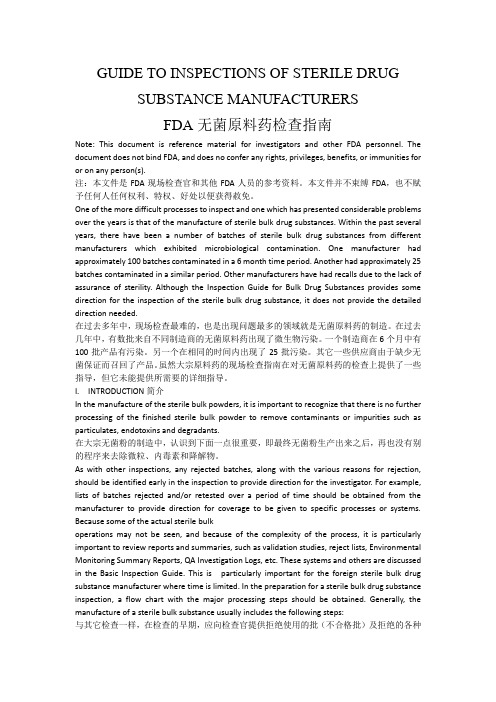
GUIDE TO INSPECTIONS OF STERILE DRUG SUBSTANCE MANUFACTURERSFDA无菌原料药检查指南Note: This document is reference material for investigators and other FDA personnel. The document does not bind FDA, and does no confer any rights, privileges, benefits, or immunities for or on any person(s).注:本文件是FDA现场检查官和其他FDA人员的参考资料。
本文件并不束缚FDA,也不赋予任何人任何权利、特权、好处以便获得赦免。
One of the more difficult processes to inspect and one which has presented considerable problems over the years is that of the manufacture of sterile bulk drug substances. Within the past several years, there have been a number of batches of sterile bulk drug substances from different manufacturers which exhibited microbiological contamination. One manufacturer had approximately 100 batches contaminated in a 6 month time period. Another had approximately 25 batches contaminated in a similar period. Other manufacturers have had recalls due to the lack of assurance of sterility. Although the Inspection Guide for Bulk Drug Substances provides some direction for the inspection of the sterile bulk drug substance, it does not provide the detailed direction needed.在过去多年中,现场检查最难的,也是出现问题最多的领域就是无菌原料药的制造。
FDA行业指南 委托生产质量协议 中英文
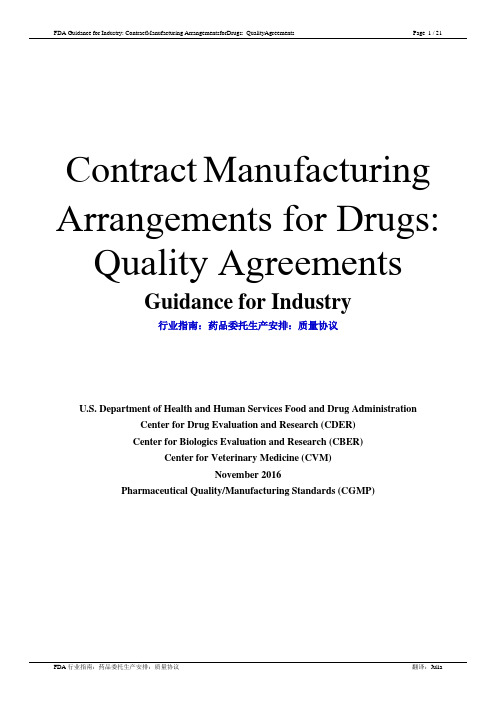
Contract Manufacturing Arrangements for Drugs: Quality AgreementsGuidance for Industry行业指南:药品委托生产安排:质量协议U.S. Department of Health and Human Services Food and Drug AdministrationCenter for Drug Evaluation and Research (CDER)Center for Biologics Evaluation and Research (CBER)Center for Veterinary Medicine (CVM)November 2016Pharmaceutical Quality/Manufacturing Standards (CGMP)Guidance for IndustryAdditional copies are available from:Office of Communications, Division of Drug Information Center for Drug Evaluation and ResearchFood and Drug Administration10001 New Hampshire Ave., Hillandale Bldg., 4th Floor Silver Spring, MD 20993-0002Phone: 855-543-3784 or 301-796-3400; Fax: 301-431-6353Email: druginfo@/Drugs/GuidanceComplianceRegulatoryInformation/Guidances/default.htmand/orOffice of Communication, Outreach and Development Center for Biologics Evaluation and ResearchFood and Drug Administration10903 New Hampshire Ave., Bldg. 71, Room 3128Silver Spring, MD 20993-0002Phone: 800-835-4709 or 240-402-8010Email: ocod@/BiologicsBloodVaccines/GuidanceComplianceRegulatoryInformation/Guidances/default.htmand/orPolicy and Regulations Staff, HFV-6Center for Veterinary Medicine Food and Drug Administration7519 Standish Place, Rockville, MD 20855/AnimalVeterinary/GuidanceComplianceEnforcement/GuidanceforIndustry/default.htmU.S. Department of Health and Human Services Food and Drug Administration Center for Drug Evaluation and Research (CDER)Center for Biologics Evaluation and Research (CBER)Center for Veterinary Medicine (CVM)November 2016Pharmaceutical Quality/Manufacturing Standards (CGMP)TABLE OF CONTENTS 目录TABLE OF CONTENTS 目录 (3)I. INTRODUCTION前言 (4)II. DEFINING THE WHO AND WHAT OF CONTRACT MANUFACTURING指定委托生产的人和事 (6)III. RESPONSIBILITIES OF PARTIES INVOLVED IN CONTRACT MANUFACTURING委托生产所涉及各方的职责7 IV. DOCUMENTING CGMP ACTIVITIES IN QUALITY AGREEMENTS在质量协议中记录CGMP活动 (10)A.What Is a Quality Agreement? 什么是质量协议? (10)B.Elements of a Quality Agreement 质量协议的要素 (11)V. ILLUSTRATIVE SCENARIOS案例 (17)A.Owners and Contract Facilities Are Both Responsible for CGMP 所有者和受托场所是否都对CGMP负责?18B.CGMPs Apply to all Contract Facilities, Including Analytical Testing Laboratories 适用于所有合同场所,包括分析化验室的CGMP (19)C.Owners and Contract Facilities Perform Change Control Activities 所有者和受托方实施变更控制活动20VI. RECOMMENDATIONS建议 (21)Contract Manufacturing Arrangements for Drugs:QualityAgreementsGuidance for Industry1行业指南:药品委托生产安排:质量协议I.INTRODUCTION 前言This guidance describes FDA’s current thinking on defining, establishing, and documentingmanufacturing activities of the parties involved in contract drug manufacturing subject to current good manufacturing practice (CGMP) requirements. In particular, we describe how partiesinvolved in contract drug manufacturing can use quality agreements to delineate theirmanufacturing activities to ensure compliance with CGMP.本指南讲述了FDA当前对于受到CGMP约束的药品委托生产所涉及各方如何定义、设立和记录生产活动的看法,尤其是药品委托各方如何使用质量协议来描绘其生产活动,以确保符合CGMP。
《美国FDA化妆品良好操作规范(FDA-CGMP)》中文版

美国食品和药品管理局Cosmetic Good Manufacturing Practice Guidelines化妆品良好生产规范指南联邦食品、药品和化妆品法案(The Federal Food, Drug and Cosmetic Act, 以下简称FD&C 法案)禁止在州际直接贸易的化妆品是掺杂的或贴假标签的情况。
(Sec. 301)以下4种情况下,化妆品被认为是可能掺杂的:1.在用户使用过程中,由于化妆品本身含有或在包装容器中有潜在的、对人体有害的成分而使用户受到伤害的;2.本身含有不洁成分的;3.本身含有禁用成分,例如:未认可的色素添加剂;4.在不卫生条件下生产的、或保留的,可导致产品伤害用户有害或被不洁成分所污染。
以下几种情况下,化妆品被认为可能会认为贴假标签(Sec. 602):1.虚假的标签或存在误导信息的标签2.显著违反了联邦食品、药品和化妆品法案的要求在标签上声明的信息要求3.在容器上有误导的信息为了确定化妆品生产厂家是否保留或发货了掺杂的、或是贴假标签的化妆品,和防止这些违反了FD&C 法案生产的化妆品流入市场,法律给了FDA进入这些化妆品工厂检查的权利,包括检查相关工厂的设备,成品,原料,容器和标签。
(见Sec. 704(a) of the FD&C Act.)如果工厂严格的根据良好的操作规范(GMP)的要求生产,将最低限度的减少掺杂的,或贴假标签的情况。
随后的化妆品指导,引用于FDA检查操作手册(FDA's Inspection Operations Manual),可以作为指南,用来有效的进行自我检查除。
良好的检查得分则意味着工厂执行了良好的操作规范(GMP)的要求。
指南1.建筑物和设施:检查是否a.用于生产或存放化妆品的建筑物应大小合适,设计和结构应保证设备进出不受阻碍,材料存放整洁,操作卫生以及正确的清洁和维护;b.地面,墙壁和天花板结构表面应光滑,易于清洁,并保持干净和良好状况;c.安装的固定装置,管道的滴水或者冷凝水不会污染化妆品原料,器具,以及与化妆品原料,散装产品或成品接触的设备的表面;d.照明和排风系统应满足预期员工操作和舒适的要求;e.供水,清洗和卫生设施,地面排水和废水系统应充分满足清洁操作的要求,和设备、器具的清洁要求,以及满足员工的需要并易于让员工保持个人清洁2.设备:检查是否a.加工、盛放、中转和灌装过程使用的设备和器具应设计合理,使用的材料和工艺能防止腐蚀、污垢的堆积、以及被润滑油、灰尘或者消毒剂污染;b.器具,运送管道以及和化妆品接触的设备表面应维护良好,并定期清洁和消毒;c.清洁和消毒后的便携式设备和器具应妥善放置,与化妆品接触的设备表面应罩住,以防止飞溅,灰尘或其他污染物3.员工: 检查是否a.监督化妆品的生产或者控制的员工应具有一定的教育背景,培训和/或经验来执行指定的监督工作;b.为防止化妆品掺杂,与化妆品原料,散装成品或化妆品接触表面直接接触的员工,应穿戴适合的工作服,手套,头套等,并保持良好的个人清洁;c.吃东西,喝水,或者抽烟都应严格限制在制定的区域。
FDA工业指南--CGMP质量体系(中文译稿)

Guidance for IndustryQuality Systems Approach to Pharmaceutical CGMP Regulations业界指南——制药企业CGMP规范的质量体系U.S. Department of Health and Human ServicesFood and Drug AdministrationCenter for Drug Evaluation and Research (CDER)Center for Biologics Evaluation and Research (CBER)Center for Veterinary Medicine (CVM)Office of Regulatory Affairs (ORA)September 2006Pharmaceutical CGMPs目录Ⅰ简介Ⅱ背景和目的A 背景B 指南的目标C 指南适用范围D 指南的组织结构Ⅲ CGMP和现代质量系统的概念A 质量B 质量设计和产品开发C 质量风险管理D CAPA(纠偏和预防措施)E 变更控制F 质量部门G 六系统检查模式IV 质量系统模型A 管理责任1 授予领导权2 构建组织3 建立符合要求的质量系统4 建立方针政策、目标和计划5 系统审核B资源1 授予领导权2人员提高3厂房和设备4对外包工作的控制C生产制造1产品和生产工艺的设计、开发和文件化2检查输入3运作的执行和监控4 非一致性D 评估活动1 数据的趋势分析2 内部审核3 质量风险管理4 纠偏措施5 预防措施6 推动改善V 结论术语表(本指南代表了FDA对质量体系当前的思考。
它既没有为任何人也不是为赋予任何人利益而制定。
并且其操作也不对FDA或公众形成约束。
只要能够满足对现行法规和规范的要求你可以采用其它方法。
如果你有兴趣讨论其它方法,可以联系负责执行本指南的FDA人员。
如果你无法确认恰当的FDA人员,可以拨打本指南公布的电话。
2011-FDA行业指南_工艺验证(中英文对照):一般原则与规范
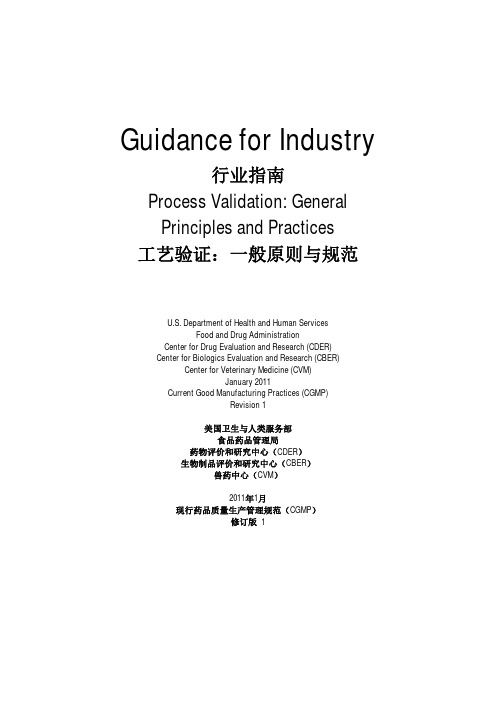
和/或 马里兰州洛克维尔市Standish Place 7519号食品药品管理局兽药中心HFV-12通讯处,邮政编码:
/Drugs/GuidanceComplianceRegulatoryInformation/Guidances/default.htm
and/or Office of Communication, Outreach and Development, HFM-40 Center for Biologics Evaluation and Research Food and Drug Administration 1401 Rockville Pike, Rockville, MD 20852-1448 (Tel) 800-835-4709 or 301-827-1800
/BiologicsBloodVaccines/GuidanceComplianceRegulatoryInformation/Guidances/default.htm
and/or Communications Staff, HFV-12 Center for Veterinary Medicine Food and Drug Administration 7519 Standish Place, Rockville, MD 20855 (Tel) 240-276-9300
包含不具约束力的建议
Guidance for Industry
行业指南 Process Validation: General Principles and Practices 工艺验证:一般原则与规范
美国FDA制剂厂检查指南-CGMP
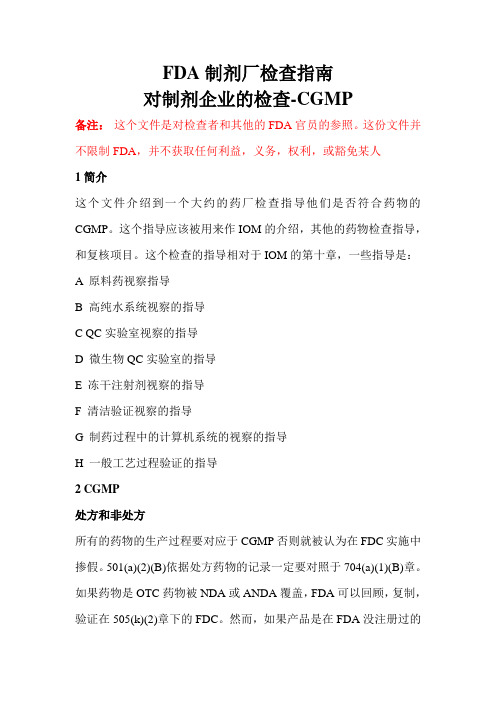
FDA制剂厂检查指南对制剂企业的检查-CGMP备注:这个文件是对检查者和其他的FDA官员的参照。
这份文件并不限制FDA,并不获取任何利益,义务,权利,或豁免某人1简介这个文件介绍到一个大约的药厂检查指导他们是否符合药物的CGMP。
这个指导应该被用来作IOM的介绍,其他的药物检查指导,和复核项目。
这个检查的指导相对于IOM的第十章,一些指导是:A 原料药视察指导B 高纯水系统视察的指导C QC实验室视察的指导D 微生物QC实验室的指导E 冻干注射剂视察的指导F 清洁验证视察的指导G 制药过程中的计算机系统的视察的指导H 一般工艺过程验证的指导2 CGMP处方和非处方所有的药物的生产过程要对应于CGMP否则就被认为在FDC实施中掺假。
501(a)(2)(B)依据处方药物的记录一定要对照于704(a)(1)(B)章。
如果药物是OTC药物被NDA或ANDA覆盖,FDA可以回顾,复制,验证在505(k)(2)章下的FDC。
然而,如果产品是在FDA没注册过的OTC药物。
并没有法定的严格要求在视察过程中给视察者看的的记录要按704章FDC的要求。
而且,所有的处方药和OTC 药的生产必须符合CGMP的要求,包括那些记录。
视察者应该回顾这些记录作为决定是否符合CGMP要求的一部分。
在很少的场合,可以拒绝回顾OTC的记录因为并没有法定要求这样做。
当工厂在没有法定义务去提供回顾这些记录时,没有减轻需要符合在501(a)(2)(B)CGMP 的要求,包括对主体文件的要求。
如果一个工厂拒绝回顾OTC的记录,视察者应该被其他的视察方法决定特别符合CGMP的要求。
视察者观察和查找对于处方药和非处方药并不根据FDA-483确定的检查表中做的行为。
组织和人员工厂一定要有QC控制文件描述CFR的责任和权威。
QC文件一定要在表明它的相对于生产文件的独立性,在书面表明它的责任权属。
表明操作者的官员的名字,头衔和内在的责任,其他的主要的职员在IOM中列出。
FDA无菌生产cGMP指南(中文)[1]
![FDA无菌生产cGMP指南(中文)[1]](https://img.taocdn.com/s3/m/a525acfcfab069dc50220154.png)
行业指南无菌制造工艺生产 无菌药品的cGMP美国FDA2004年9月目 录I.引言II.背景A.法规框架B.技术框架III.范围IV.厂房与设施A.关键区-100级(ISO 5)B.支持洁净区C.洁净区分隔D.空气过滤1.滤膜2.高效空气过滤(HEPA)E.设计V.人员培训、确认和监督A.人员B.实验室人员C.监督计划VI.组分和容器/胶塞A.组分B.容器/胶塞1.准备2.检查容器胶塞密封系统VII.内毒素控制VIII.时限IX.无菌工艺与灭菌的验证A.工艺模拟试验1.设计研究2.频率和试验次数3.试验时间4.试验批量5.灌装线运行速度6.环境条件7.培养基8.培养基灌装产品的培养和检查9.试验结果的解释B.过滤效率C.设备、容器和胶塞的灭菌1.确认和验证2.设备监控和仪表校验X.实验室管理A.环境监控1.总体书面计划2.确定限度和趋势分析计划3.消毒效率4.监控方法B.微生物培养基和鉴别C.过滤前产品微生物载量D.供替换的微生物试验方法E.尘粒监控XI.无菌检查A.微生物实验室管理B.取样和培养C.无菌检查阳性调查XII.批记录审核:生产工艺控制文件附录1:无菌作业隔离器附录2:吹-灌-封技术附录3:过滤前的作业和密封作业参考文献术语I.引言II.背景A.法规框架B.技术框架III.范围IV.厂房与设施A.关键洁净区-100级(ISO 5)B.支持性洁净区C.洁净区分隔D.空气过滤1.滤膜压缩气体应有适当的纯度(如不含油),且经过滤后微生物和微粒方面的质量应相当于或优于其导入环境的空气质量。
洁净间经常使用的压缩气体如压缩空气、氮气和二氧化碳,通常用于清洁和保护目的。
膜过滤器可用于过滤压缩气体以达到高质量标准。
进行无菌作业时,如处理无菌物料和操作无菌设备使用的无菌气体,通常由这类过滤器过滤后获取。
FDA建议在例如通往灭菌釜腔室的空气管道中、在消除冻干机内的真空时、及存有无菌物料的储罐上采用无菌膜过滤器。
FDA工业指南--CGMP的质量体系(中文译稿)

Guidance for IndustryQuality Systems Approach to Pharmaceutical CGMP Regulations业界指南——制药企业CGMP规范的质量体系U.S. Department of Health and Human ServicesFood and Drug AdministrationCenter for Drug Evaluation and Research (CDER)Center for Biologics Evaluation and Research (CBER)Center for Veterinary Medicine (CVM)Office of Regulatory Affairs (ORA)September 2006Pharmaceutical CGMPs目录Ⅰ简介Ⅱ背景和目的A 背景B 指南的目标C 指南适用范围D 指南的组织结构Ⅲ CGMP和现代质量系统的概念A 质量B 质量设计和产品开发C 质量风险管理D CAPA(纠偏和预防措施)E 变更控制F 质量部门G 六系统检查模式IV 质量系统模型A 管理责任1 授予领导权2 构建组织3 建立符合要求的质量系统4 建立方针政策、目标和计划5 系统审核B资源1 授予领导权2人员提高3厂房和设备4对外包工作的控制C生产制造1产品和生产工艺的设计、开发和文件化2检查输入3运作的执行和监控4 非一致性D 评估活动1 数据的趋势分析2 内部审核3 质量风险管理4 纠偏措施5 预防措施6 推动改善V 结论术语表(本指南代表了FDA对质量体系当前的思考。
它既没有为任何人也不是为赋予任何人利益而制定。
并且其操作也不对FDA或公众形成约束。
只要能够满足对现行法规和规范的要求你可以采用其它方法。
如果你有兴趣讨论其它方法,可以联系负责执行本指南的FDA人员。
如果你无法确认恰当的FDA人员,可以拨打本指南公布的电话。
FDA工业指南用无菌工艺生产的无菌药品
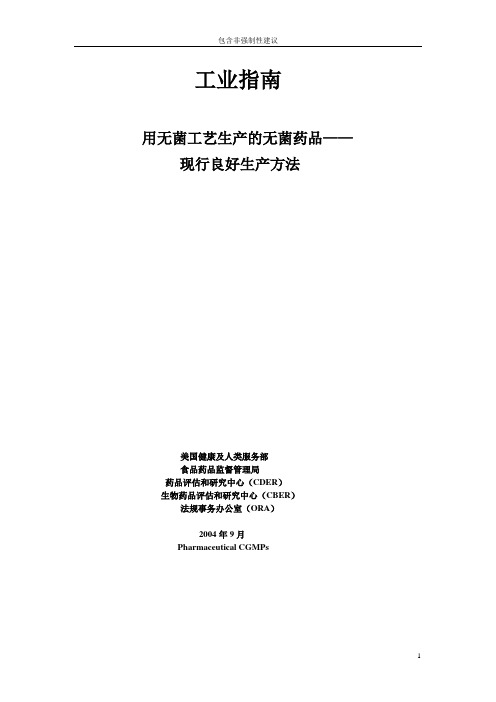
用无菌工艺生产的无菌药品——现行良好生产方法美国健康及人类服务部食品药品监督管理局药品评估和研究中心(CDER)生物药品评估和研究中心(CBER)法规事务办公室(ORA)2004年9月Pharmaceutical CGMPs用无菌工艺生产的无菌药品——现行良好生产方法美国健康及人类服务部食品药品监督管理局药品评估和研究中心(CDER)生物药品评估和研究中心(CBER)法规事务办公室(ORA)2004年9月Pharmaceutical CGMPs目录I、序言 (5)II、背景 (6)A、法规规章 (6)B、技术方面 (6)III、范围 (7)Ⅳ、厂房设施 (7)A、关键生产区-100级(ISO5) (8)B、辅助洁净区 (10)C、洁净区的分隔 (10)D、空气过滤 (10)1、膜 (10)2、高效空气过滤器(HEPA) (11)E、设计 (12)Ⅴ、人员培训、确认及监控 (14)A、人员 (15)B、实验室人员 (16)C、监控计划 (16)Ⅵ、组分和容器/密封件 (17)A、组分 (17)B、容器/密封件 (18)1、准备工作 (18)2、容器密封件系统的检查 (19)Ⅶ、内毒素的控制 (19)Ⅷ、时间限制 (20)Ⅸ、无菌生产加工方法及灭菌的验证 (20)A、模拟生产过程 (20)1、试验研究的设计 (21)2、运行的频次和次数 (22)3、运行的持续时间 (22)4、模拟运行的规模 (23)5、生产线的运行速度 (23)6、环境条件 (23)7、培养基 (23)8、灌装培养基单件的培养及检定 (24)9、检验结果的说明 (25)B、过滤效率 (26)C、设备、容器和密封件的灭菌 (27)1、确认和验证 (27)2、设备控制和仪器校验 (28)Ⅹ、实验室控制 (29)A、环境监控 (30)1、总的书面规划 (30)2、制定限量及趋势方案 (30)3、消毒灭菌效果 (31)4、监测方法 (31)B、微生物培养基及鉴别 (32)C、过滤前的微生物量 (32)D、可替代的微生物检验方法 (32)E、微粒监测 (33)Ⅺ、无菌检验 (33)A、微生物实验室控制 (34)B、取样及培养 (34)C、无菌试验阳性的调查研究 (35)Ⅻ、批生产记录审核:工艺控制文件 (36)附件1:无菌生产加工的隔离物 (38)附件2:吹—灌—封技术 (42)附件3:灌装及封口操作前的生产加工 (44)参考文献 (46)相关的指南文件 (48)术语汇编 (49)工业指南1用无菌生产加工方法生产的无菌药品——现行良好生产方法Ⅰ、序言本指南是要帮助用无菌生产加工方法生产无菌药品和生物制品生产单位,以符合FDA的CGMP 法规(21CFR210和211)。
美国FDA原料药生产质量管理规范中英文

DIRECTION OF GMP (GOOD MANUFACTURING PRACTICE )OF RAW M A T E R I A L S B Y F D A 美国FDA原料药生产质量管理规范(中英文)Table of Contents目录1. INTRODUCTION简介Objective 目的Regulatory Applicability法规的适用性Scope 范围2. QUALITY MANAGEMENT .质量管理Principles 总则Responsibilities of the Quality Unit(s) 质量部门的责任Responsibility for Production Activities 生产作业的职责Internal Audits (Self Inspection) 内部审计(自检)Product Quality Review 产品质量审核3. PERSONNEL 人员Personnel Qualifications 人员的资质Personnel Hygiene 人员卫生Consultants 顾问4. BUILDINGS AND FACILITIES 建筑和设施Design and Construction 设计和结构Utilities 公用设施Water 水Containment 限制Lighting 照明Sewage and Refuse 排污和垃圾Sanitation and Maintenance 卫生和保养5. PROCESS EQUIPMENT 工艺设备Design and Construction 设计和结构Equipment Maintenance and Cleaning 设备保养和清洁Calibration. 校验Computerized Systems 计算机控制系统6. DOCUMENTATION AND RECORDS 文件和记录Documentation System and Specifications 文件系统和质量标准Equipment cleaning and Use Record 设备的清洁和使用记录Records of Raw Materials, Intermediates, API Labeling and Packaging Materials 原料、中间体、原料药的标签和包装材料的记录Master Production Instructions (Master Production and Control Records)生产工艺规程(主生产和控制记录)Batch Production Records (Batch Production and Control Records)批生产记录(批生产和控制记录)Laboratory Control Records 实验室控制记录Batch Production Record Review 批生产记录审核7. MATERIALS MANAGEMENT 物料管理General Controls 控制通则Receipt and Quarantine 接收和待验Sampling and Testing of Incoming Production Materials 进厂物料的取样与测试Storage 储存Re-evaluation 复验8. PRODUCTION AND IN-PROCESS CONTROLS 生产和过程控制Production Operations 生产操作Time Limits 时限In-process Sampling and Controls 工序取样和控制Blending Batches of Intermediates or APIs 中间体或原料药的混批Contamination Control 污染控制9. PACKAGING AND IDENTIFICATION LABELING OF APIs AND INTERMEDIATES原料药和中间体的包装和贴签General 总则Packaging Materials 包装材料Label Issuance and Control 标签发放与控制Packaging and Labeling Operations 包装和贴签操作10. STORAGE AND DISTRIBUTION.储存和分发Warehousing Procedures 入库程序Distribution Procedures 分发程序11. LABORATORY CONTROLS 实验室控制General Controls 控制通则Testing of Intermediates and APIs 中间体和原料药的测试Validation of Analytical Procedures 分析方法的验证Certificates of Analysis分析报告单Stability Monitoring of APIs 原料药的稳定性监测Expiry and Retest Dating 有效期和复验期Reserve/Retention Samples 留样12. VALIDATION .验证Validation Policy 验证方针Validation Documentation 验证文件Qualification 确认Approaches to Process Validation 工艺验证的方法Process Validation Program 工艺验证的程序Periodic Review of Validated Systems 验证系统的定期审核Cleaning Validation 清洗验证Validation of Analytical Methods 分析方法的验证13. CHANGE CONTROL 变更的控制14. REJECTION AND RE-USE OF MATERIALS.拒收和物料的再利用Rejection 拒收Reprocessing 返工Reworking 重新加工Recovery of Materials and Solvents 物料与溶剂的回收Returns 退货15. COMPLAINTS AND RECALLS 投诉与召回16. CONTRACT MANUFACTURERS (INCLUDING LABORATORIES)协议生产商(包括实验室)17. AGENTS, BROKERS, TRADERS, DISTRIBUTORS, REPACKERS, AND RELABELLERS 代理商、经纪人、贸易商、经销商、重新包装者和重新贴签者Applicability 适用性Traceability of Distributed APIs and Intermediates已分发的原料药和中间体的可追溯性Quality Management 质量管理Repackaging, Relabeling, and Holding of APIs and Intermediates原料药和中间体的重新包装、重新贴签和待检Stability 稳定性Transfer of Information 信息的传达Handling of Complaints and Recalls 投诉和召回的处理Handling of Returns 退货的处理18. Specific Guidance for APIs Manufactured by Cell Culture/Fermentation 用细胞繁殖/发酵生产的原料药的特殊指南General 总则Cell Bank Maintenance and Record Keeping 细胞库的维护和记录的保存Cell Culture/Fermentation 细胞繁殖/发酵Harvesting, Isolation and Purification 收取、分离和精制Viral Removal/Inactivation steps 病毒的去除/灭活步骤19. APIs for Use in Clinical Trials 用于临床研究的原料药General 总则Quality 质量Equipment and Facilities设备和设施Control of Raw Materials 原料的控制Production 生产Validation 验证Changes 变更Laboratory Controls 实验室控制Documentation 文件20. Glossary 术语1. INTRODUCTION 1. 简介Objective 目的This document is intended to provide guidance regarding good manufacturing practice (GMP) for the manufacturing of active pharmaceutical ingredients (APIs) under an appropriate system for managing quality. It is also intended to help ensure that APIs meet the quality and purity characteristics that they purport, or are represented, to possess.本文件旨在为在合适的质量管理体系下制造活性药用成分(以下称原料药)提供有关优良药品生产管理规范(GMP)提供指南。
- 1、下载文档前请自行甄别文档内容的完整性,平台不提供额外的编辑、内容补充、找答案等附加服务。
- 2、"仅部分预览"的文档,不可在线预览部分如存在完整性等问题,可反馈申请退款(可完整预览的文档不适用该条件!)。
- 3、如文档侵犯您的权益,请联系客服反馈,我们会尽快为您处理(人工客服工作时间:9:00-18:30)。
行业指南无菌制造工艺生产 无菌药品的cGMP美国FDA2004年9月目 录I.引言II.背景A.法规框架B.技术框架III.范围IV.厂房与设施A.关键区-100级(ISO 5)B.支持洁净区C.洁净区分隔D.空气过滤1.滤膜2.高效空气过滤(HEPA)E.设计V.人员培训、确认和监督A.人员B.实验室人员C.监督计划VI.组分和容器/胶塞A.组分B.容器/胶塞1.准备2.检查容器胶塞密封系统VII.内毒素控制VIII.时限IX.无菌工艺与灭菌的验证A.工艺模拟试验1.设计研究2.频率和试验次数3.试验时间4.试验批量5.灌装线运行速度6.环境条件7.培养基8.培养基灌装产品的培养和检查9.试验结果的解释B.过滤效率C.设备、容器和胶塞的灭菌1.确认和验证2.设备监控和仪表校验X.实验室管理A.环境监控1.总体书面计划2.确定限度和趋势分析计划3.消毒效率4.监控方法B.微生物培养基和鉴别C.过滤前产品微生物载量D.供替换的微生物试验方法E.尘粒监控XI.无菌检查A.微生物实验室管理B.取样和培养C.无菌检查阳性调查XII.批记录审核:生产工艺控制文件附录1:无菌作业隔离器附录2:吹-灌-封技术附录3:过滤前的作业和密封作业参考文献术语I.引言II.背景A.法规框架B.技术框架III.范围IV.厂房与设施A.关键洁净区-100级(ISO 5)B.支持性洁净区C.洁净区分隔D.空气过滤1.滤膜压缩气体应有适当的纯度(如不含油),且经过滤后微生物和微粒方面的质量应相当于或优于其导入环境的空气质量。
洁净间经常使用的压缩气体如压缩空气、氮气和二氧化碳,通常用于清洁和保护目的。
膜过滤器可用于过滤压缩气体以达到高质量标准。
进行无菌作业时,如处理无菌物料和操作无菌设备使用的无菌气体,通常由这类过滤器过滤后获取。
FDA建议在例如通往灭菌釜腔室的空气管道中、在消除冻干机内的真空时、及存有无菌物料的储罐上采用无菌膜过滤器。
为避免微生物污染,无菌药液储罐及其液体应维持正压或采用适当的密封措施。
应安装相应的安全装置,以防止可引起非无菌空气或液体倒流从而造成污染的压力波动。
气体过滤器(包括呼吸过滤器)应保持干燥。
气体过滤器上的冷凝水能在使用过程中造成堵塞或促使微生物生长。
使用疏水性过滤器,以及采用适当的过滤器加热装置,能防止上述冷凝水的问题。
FDA建议对能影响产品无菌特性的过滤器在安装后进行完整性检查,并此后定期(如使用后)进行该项检查,这些过滤器包括:无菌呼吸过滤器和气体除菌过滤器。
建议在可能损坏过滤器的活动后也进行完整性检查。
应对完整性检查失败进行调查,应制定明确的、适当的过滤器更换周期。
2.高效空气过滤(HEPA)应保证高效空气过滤器的完整性以确保无菌环境。
应在高效过滤器安装后进行检漏试验,以检查密封条、框架和过滤器表面各处是否有裂缝。
此后,应定期对无菌作业区内的高效过滤器进行检漏试验。
例如,该试验应每年进行两次。
当发现空气质量超标、设施改造可能引起天花板和墙体结构扰动时,或作为培养基灌装及产品无菌检查失败调查的一部分,可能需要进行额外的检漏试验。
安装在除热源干热隧道或其它用于玻璃容器除热源烘箱内的高效过滤器也应作检漏试验。
理由充分时,可采用替代方法检查安装在隧道和其它烘箱加热段的高效过滤器。
任何用于挑战高效过滤器的气溶胶应符合关键的物理化学特性标准,如粘度。
检漏试验所用的适宜的气溶胶为邻苯二甲酸二辛酯(DOP)或聚-α-烯烃(PAO)。
有些气溶胶存在增加受试环境微生物污染风险的问题。
因此,评价替代用气溶胶的效果应证明其不会促使微生物的生长。
过滤器检漏试验和过率效率试验间有重要的区别。
过滤效率试验是用于测量过滤器等级的常规方法。
完好的高效过滤器应能滞留至少99.97%的直径大于0.3微米的微粒。
另一方面,进行定期检漏试验的目的,是检测过滤器材料、框架或安装密封是否存在泄漏。
挑战性试验包括使用充分分散的由光散射平均粒径小于1微米的微粒组成的气溶胶,其中含足够数量的粒径约0.3微米的微粒。
如果不在过滤器上游导入足够数量已知粒径的微粒,则该检漏试验是无效的。
检漏试验的要点是在过滤器上游导入与气溶胶光度计测量准确度匹配的适当浓度的气溶胶。
检漏试验应在线进行,使用适当的光度计扫描过滤器的下游面,采样速度至少每分钟1立方英尺。
应将仪器测得的下游泄漏数据换算成上游挑战浓度的百分数。
扫描应覆盖整个过滤器和框架,扫描的位置是距过滤器面1至2英寸。
该试验应完整地记录。
单个泄漏率读数达到上游挑战浓度的0.01%应视为存在明显泄漏的迹象,从而需要更换高效过滤器或在有限的范围内修复。
任何修复措施后应进行再次试验以确认修复效果。
单独的高效过滤器检漏试验不足以监控过滤器的性能。
还应定期测定过滤器的其它特性,如过滤器流速均匀性(以及与邻近过滤器比较)以监控其状态。
流速的变化可导致紊流进而增加污染的概率。
关键区域内高效过滤器的单向空气流速应在过滤器表面6英寸处以及离工作面特定距离处测量。
以适当的频率检查空气流速可提供评价无菌操作关键区域状况的有价值的数据。
有关数据应同最初确定洁净区内气流方向时测量并制定的流速范围作比较。
当发现过滤器一定范围内的空气流速不均匀或可能改变区域空气流向时,应更换高效过滤器。
虽然通常可委托外部机构提供上述检测服务,但保证制定了相关设备规格、测试方法和合格标准,并保证这些基本的认证活动正确地实施是药品生产企业的责任。
E.设计V.人员培训、确认和监督A.人员B.实验室人员C.监督计划VI.组分和容器/胶塞A.组分B.容器/胶塞1.准备2.检查容器胶塞密封系统VII.内毒素控制VIII.时限IX.无菌工艺与灭菌的验证A.工艺模拟试验1.设计研究2.频率和试验次数3.试验时间4.试验批量5.灌装线运行速度6.环境条件7.培养基8.培养基灌装产品的培养和检查9.试验结果的解释B.过滤效率过滤是药品溶液除菌的常用方法。
应通过验证证明除菌过滤器能可再现地将产品溶液中的活微生物除去以得到无菌的滤液。
目前,上述过滤器通常的平均孔径为0.2微米或更小。
在许多场合应考虑使用串联的除菌过滤器。
无论使用单个或组合过滤器,验证应包括旨在模拟待过滤物质的最差生产条件的微生物挑战试验以及该过滤器的完整性试验。
选择挑战用微生物时,应考虑产品微生物载量检查中发现的微生物,以确定何种微生物代表最差条件,对过滤器构成挑战性。
由于缺陷短波单胞菌的平均直径较小(0.3微米),当其生长、采集和使用条件适宜时,通常用作挑战微生物。
生产过程控制应设计为能最大程度降低产品过滤前微生物载量。
应检查除菌过滤前产品溶液中的微生物载量以掌握潜在污染微生物特性的总体情况。
在某些情况下,若有理由说明将从产品微生物载量检查分离出的微生物,用于微生物截留试验的效果相当于或优于缺陷短波单胞菌时,可以使用前者。
由于过滤器含有一定数量的大于标称等级孔径的微孔,使微生物有可能通过过滤器,因此挑战性试验所用的微生物的数量是重要的指标。
通过过滤器的概率随着待过滤溶液中微生物的数量增加而增加。
挑战试验用微生物浓度通常至少达到每平方厘米有效过滤面积107个微生物,结果应不得有微生物穿过。
验证时采用的挑战微生物浓度比生产所能遇到的微生物污染高得多,目的是为生产提供足够的安全空间。
将挑战微生物直接接入实际的药液是最好的方法,因为它能用于评价产品经过滤后的效果。
然而,将缺陷短波单胞菌直接接入具有对其有抗菌性的产品中,或含油配方的产品中,可导致错误的结论。
当有充分理由时,产品配方对过滤膜完整性的影响可用适当的替代方法评价。
例如,药品溶液可在模拟的生产工艺标准允许的最差条件下过滤。
此后在相同条件下,在足够长的时间内使含有挑战微生物的,配方经适当修改的产品(如不含抗菌防腐剂或其它抗菌成分)通过该过滤器。
任何模拟产品同实际产品和工艺条件的差异都需要判断其合理性。
可影响过滤器性能的因素通常包括(1)待过滤物料的粘度和表面张力,(2)pH,(3)物料或配方中的成分与过滤器的相容性,(4)压力,(5)流速,(6)最长使用时间,(7)温度,(8)渗透压,(9)液体冲击的影响。
设计验证方案时,应重点考察极端工艺因素对过滤效果的影响。
过滤器验证应在最差条件下进行,如最长使用时间和最高压力。
过滤器验证试验,包括微生物挑战性试验,不必在实际生产现场进行。
然而,试验必须模拟实际的生产条件。
过滤器验证应针对实际商业生产使用的特定类型的滤膜。
在这类细菌截留验证试验中,使用实际生产用的过滤器有其优点。
当过滤器用户没有能力进行这些复杂的过滤器验证时,经常委托外部实验室或过滤器生产商进行。
然而,审核关于过滤器除菌能力方面的验证数据是过滤器用户的责任。
由于过滤器的效能可因产品和使用条件不同而有重大差异,验证数据应针对过滤器用户的产品和使用条件。
针对特定产品、工艺和过滤器的过滤工艺验证完成后,应确保生产中使用该类型的过滤器(例如相同的滤膜材料和结构、孔径)。
完成一个批次的生产后,通常应丢弃该除菌过滤器。
当然,如果能证明重复使用的合理性,可以重复使用,但应通过验证确定最多使用批次。
过滤器的完整性试验可在生产前进行,且应在使用后进行。
在过滤后进行完整性试验的重要性在于发现任何在生产过程中可能发生的过滤器泄漏或贯通。
通常完整性试验可采用前进流试验和发泡点试验两种方法。
产品过滤器完整性试验标准应与细菌截留验证试验获取的数据一致。
C.设备、容器和胶塞的灭菌1.确认和验证2.设备监控和仪表校验X.实验室管理A.环境监控1.总体书面计划2.确定限度和趋势分析计划3.消毒效率4.监控方法B.微生物培养基和鉴别C.过滤前产品微生物载量D.供替换的微生物试验方法E.尘粒监控XI.无菌检查A.微生物实验室管理B.取样和培养C.无菌检查阳性调查XII.批记录审核:生产工艺控制文件 附录1:无菌作业隔离器附录2:吹-灌-封技术附录3:过滤前的作业和密封作业参考文献术语。
